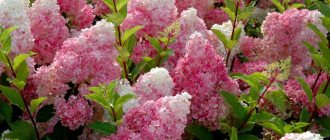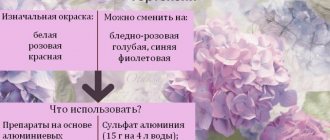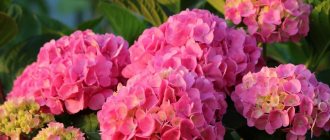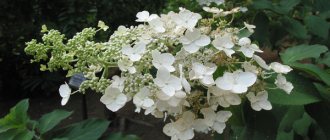Hydrangea paniculata variety Vanilla Fraise® (Vanilla Strawberry) 'Renhy' (Strawberry and Cream) is a new deciduous shrub grown for landscape use, characterized by large inflorescences (120x170 mm) of sterile flowers, the inflorescences turn white in mid-summer, changing color to pink after 2 weeks, then to red or burgundy (depending on night temperature). The red color lasts for 3-4 weeks. The leaves are oval, light to medium green in color with a rough feel on top.
Hydrangea paniculata 'Renhy' A vibrant and beautiful flowering shrub, especially because of its interesting color changes. Used as a sample for group and mass plantings, hedges, and floristry.
Hydrangea paniculata Vanilla Fraze blooms in wide pyramidal panicles from mid-July to mid-October in France. The color lasts for 4-6 weeks before darkening. The size of the bush is 2.5 m high and 1.5 m wide.
Hydrangea Vanilla Fraze 'Renny' can be compared to 'Grandiflora' (not patented) and 'Pinky Winky' (not patented). 'Grandiflora' also has large white flowers, however - all are fertile, the flowers are pink only for a short period of time. 'Pinky Winky' also has white flowers that turn pink and red for only a short period of time.
Origin
The new hydrangea variety resulted from a controlled propagation program that began in 1987 (Garrone, France), with the goal of producing a selection of hydrangeas that bloomed early in the season with red, sterile flowers. The inventors began the breeding program by selfing Hydrangea paniculata 'Unique' (not patented), the parents of 'Renhy' being unnamed private seedlings produced after seven series of subsequent crosses. In 2002, Hydrangea 'Renhy' was selected as the only unique plant among the progeny (Garron, France).
The new variety was first propagated from cuttings in May 2003 by the inventors in Garron, France. The characteristics of the new variety were determined to be stable and reproduced according to type in subsequent generations.
The Vanilla Fraze hydrangea variety was introduced by Bailey Nurseries in 2009.
Patent number PP20670, Inventors: Jean Renault, Thierry Renault, Eric Renault.
Characteristics of hydrangeas
Hydrangea paniculata belongs to the genus Hydrangea and the Hydrangeaceae family. Under natural conditions, these beautifully flowering perennials can be found on the Japanese islands, in most provinces of China, as well as in the southern part of Sakhalin Island.
Interesting! This beautiful perennial was cultivated many decades ago and is currently actively used by landscape designers when creating various park compositions. And gardeners are happy to grow various varieties of paniculate hydrangeas in their gardens.
Distinctive features of these plants:
- this tree or bushes reach a height of 1.5 to 10 m;
- the root system is not deeply buried, but their diameter exceeds the size of the hydrangea crown;
- hydrangea foliage is oval and can reach 10-12 cm in length;
- the flowers are collected in pyramidal paniculate inflorescences, the length of which is about 24 cm;
- flowers of two types: sterile, the size of which can be over 2 cm, the color of the petals is white with a green tint and gradually changes to pink; small, from which fruits subsequently appear; the petals on such flowers fall off quickly;
- fruits are boxes containing a lot of small seed material; when ripe, the box cracks in the upper part;
- The first buds appear on this flowering perennial 4-5 seasons after the seedlings are planted in a permanent place.
This is interesting: hydrangea seeds have almost 100% germination.
Landing
The shrub grows best in moist, well-drained, humus-rich soil in sun or partial shade. For planting, soil with a pH of 6.1-6.5 (slightly acidic) to 6.6-7.5 (neutral) is suitable.
The best time to plant Vanilla Fraze is in late fall, when Hydrangea paniculata goes into dormancy, or in the spring, before rapid growth begins.
You can add compost to enrich poor soil. Before transplanting the seedling, you need to dig a hole as deep as the root ball and 2-3 times wider. Place the plant in the hole and fill it halfway with soil, water it, and after absorbing the water, fill the rest of the hole with soil. Water thoroughly.
Place several hydrangeas at a distance of 1-3 m. The plant will begin to bloom a year or two after planting.
Preparation of planting material and propagation
Hydrangeas paniculata Vanilla Fraze can be propagated in several ways. Each of them has its own characteristics.
Cuttings
The fastest and most affordable way to propagate a plant is by cuttings. The procedure is performed in the spring and summer. You can root shoots cut during pruning. It is important that the cuttings have at least 2 buds. On the day of planting the seedling in the soil, it is recommended to make a solution of a biostimulant (for example, “Kornevin”) and dip the roots of the seedlings in it for 2 hours.
Plant in a permanent place, or in containers with soil made of sand and peat, taken in equal quantities. Direct ultraviolet rays should not fall on the leaves, so it is recommended to choose an area with partial shade. Cover young plants with polyethylene to stimulate root growth.
For rooting, it is necessary to regularly water, spray and ventilate the cuttings. If these conditions are met, the young plant will take root within 2 weeks. To make it stronger, it is grown in a pot until next spring, after which it is planted in a permanent place in the garden. In winter, it is necessary to provide young bushes with reliable protection from frost.
By layering
Instructions for propagation by layering:
- Select the strongest lower branch from the bush.
- Bend it to the ground.
- Dig in lightly.
- Fix the layering in the ground by any means (for example, with a regular pin).
- Constantly moisten the soil.
The equine system of the layer will appear in a month. Use an ax or shovel to separate it from the mother bush and plant it in a hole prepared in advance.
Dividing the bush
Reproduction is carried out during transplantation of an adult plant. Carefully dig up the shrub, trying to cause minimal damage to the root system. Divide it into several parts with an ax or shovel. In this case, the divisions should have 2 growth points from the roots, as well as shoots with 3 buds. Treat the cut areas with charcoal powder. Plant the cuttings by preparing the hole in advance.
Seeds
Growing hydrangea from seeds to a full-fledged plant takes more than one year. This method is mainly used by breeders when developing a new variety. It is worth noting that the seed material does not fully transmit the mother variety and often the flowering differs from the plant from which the seeds were collected.
Sowing instructions for those who want to experiment:
- Prepare a container for planting. Fill with fertile mixture.
- Place the seeds on the surface and lightly sprinkle with soil. Water with settled warm water.
- Create a greenhouse effect by covering with film and placing the containers in a dark room.
- Regularly ventilate and moisten the soil.
- Remove the film after germination.
- Transplant bushes with a developed root system into individual containers or open ground.
Trimming
Hydrangea Vanilla Fraise® 'Renhy' is a variety of paniculata hydrangea that blooms on the current year's shoots. Avoid pruning once flower buds appear in the spring. Light pruning can be done after the plant has finished flowering, but pruning should be done in late winter or early spring. The general rule is to prune no more than 1/3 of the plant during the season.
Preparing the soil and planting site
Hydrangeas need space to grow well. The roots of the crop grow in breadth, suppressing the development of plants located nearby, so it is necessary to select neighbors in advance. It is not recommended to plant shrubs in an area where there are strong winds that can break branches.
Hydrangeas paniculata Vanilla Fraze develop and grow in soil that has the following qualities:
- Acidity. The indicator is not lower than 5 and not higher than 5.5 PH. A weakly expressed level will provide the plant with the necessary conditions for normal development.
- Nutritional value. The soil is prepared several months before planting: the soil is enriched with humus and fertilizers are applied.
- Looseness. Plasticity is ensured by the presence of sand. This indicator for growing hydrangea is below 7.
- Water and breathability. The soil should quickly allow moisture to pass through. Adding sand allows for breathability of the soil. Regular loosening is recommended.
For good growth and development of this variety, loamy soil is required. The soil mixture includes an equal amount of peat and turf soil, with the addition of pine or spruce compost.
Care
Hydrangea Vanilla Fraze is quite easy to care for, the shrub is frost-resistant in USDA 4, suitable for growing in the Moscow region, Moscow or St. Petersburg.
Diseases and pests. No susceptibility or resistance to diseases or pests was found.
During the first year or two after planting outdoors and during droughts, make sure hydrangeas receive enough water. Leaves wilt if the soil is too dry.
Soil rich in humus and containing many nutrients does not need to be fertilized. Light or sandy soil is best fertilized once a year in late winter or spring. Too much fertilizer promotes leaf growth at the expense of flowering.
For colder regions in the fall, cover the plant to a height of at least 50 cm with bark, leaf mulch, pine needles or straw. If possible, make cages out of chicken wire and fill the cages with leaves. (Do not use maple leaves)
Guide to planting and caring for Hydrangea varieties "Vanilla Fraze"
Although it is a hybrid, most growing conditions are no different from regular Hydrangea paniculata. Let's briefly describe them.
Soil requirement
This shrub prefers moist but well-drained soil. Sandy soil, clay or loamy soil mixture is suitable. The main condition is that there is no limestone in the ground. Improve the soil before planting by adding well-rotted manure or garden compost and mixing thoroughly.
Where to plant
Like all paniculate Hydrangeas, Vanilla Fraze can grow in a sunny area, but prefers a place with light shade. In open sun the stems will become smaller. Try to find shelter for the bush from cold drying winds.
Planting seedlings
The best time to plant Hydrangea variety "Vanilla Fries" is spring. It is advisable to purchase seedlings in containers and not with bare roots.
- First you need to dig planting holes up to 50 cm deep in the location you choose.
- Prepare an earth mixture by adding a little compost or humus to the excavated soil. If the soil is very dense, it should be fluffed up by adding sand or perlite.
- Fill the holes halfway with the prepared soil mixture.
- Carefully remove the seedlings from the container without damaging the roots. Inspect them for rot or other diseases. Remove dead roots.
- Transfer the seedlings to the holes and add the missing part of the soil. Tamp well and water the planting site. Make sure that the root collar of the bush is not buried in the soil.
- The soil surface around the seedling should be mulched.
You might be interested
Hydrangea paniculata variety 'Sunday Frize'
The best 30 varieties of Hydrangea paniculata with names and photos
Hydrangea paniculata variety "Weems Red"
Reproduction
Hydrangea Vanilla Fraze can be propagated by cuttings; rooting lasts approximately 2 weeks in the summer in greenhouse conditions without additional lighting.
To reproduce, you need to find a newly grown shoot that has not bloomed. The new shoot will be lighter than the old one and the stem will not be stiff.
From the tip of the branch, move 10-15 cm down and make a horizontal cut. Make sure that the cut cuttings have 3-4 pairs of leaves.
Remove the bottom pair of leaves from the cutting, cutting flush with the stem. Roots grow more easily from leaf nodes, so more than one pair of leaves can be removed. It is required to retain at least 2 pairs of leaves at the end of the cutting.
If the remaining leaves are quite large, cut in half, removing half the tip. This will prevent leaves from getting on the sides of the plastic bag that will be placed over the cutting (to retain moisture).
(Optional) Sprinkle the leafless part of the stem with rooting hormone and antifungal plant powder (both available at garden centers). The drugs will stimulate rooting and prevent rotting.
Prepare a small pot and fill it with moistened substrate. Plant the cutting in the soil, lowering it to the first pair of remaining leaves. Water lightly to get rid of any air gaps around the stem.
Cover the pot with a plastic bag. Make sure that the bag does not touch the leaves of the cutting, otherwise the leaves may rot. (Chopsticks can be used to prop the bag up over the leaves.)
Place the pot in a warm place, protected from direct sunlight and wind.
Check the cutting every few days to make sure it is not rotting, next watering after the top layer of soil has dried out. The cutting should take root in a few weeks! (Check, gently pull the cutting, if resistance is felt, roots have formed.)
Diseases and pests
The plant is quite resistant to diseases and insects. The most common diseases are chlorosis, powdery mildew and green leaf aphids.
Chlorosis is a disease caused by excess humus or lime in the soil. With this disease, the leaves begin to turn pale and lose their usual color.
Treatment of chlorosis is carried out with special solutions: potassium nitrate and copper sulfate with an interval of 3-4 days.
Powdery mildew is caused by excessive moisture. For treatment, you need to reduce the air humidity and treat the leaves and stems with a composition of copper sulfate with the addition of soap.
Leaf aphids are effectively destroyed with a special garlic solution . You need to take 150 grams of garlic per 10 liters of water and leave for two to three days. Then add 50 g of soap and spray the hydrangea every 5-6 days.
The exquisite beauty of Vanilla Frize hydrangea will become a real decoration of your garden. It is very unpretentious and with proper care and watering it will grow actively and delight you with its beautiful vanilla-pink inflorescences for many years.
How to cut and store dried flowers
Use dried hydrangea flowers to create a wreath or other home decorations:
- Trim the flower heads when the flowers are ripe.
- Remove leaves from stems and hang flower heads down in a warm, dry, dark, airy room.
- Once completely dry (usually a couple of weeks), store in a dry place away from direct sunlight.
- To improve the color of the flower, you can dye the inflorescences with diluted fabric dye.
Planting young bushes in the garden
When the roots of the young plants well entwined the soil in the pots, I planted them in the garden. For the Vanilla Fries variety, you need to choose a place so that the bush is well lit in the morning and afternoon, and shadow falls on it during the day.
The soil for planting was prepared from a mixture of peat, sand, garden soil, and old humus. To acidify the soil, I added a bag (30 g) of colloidal sulfur. Instead of sulfur, you can take potassium sulfate (200 g per planting hole with a diameter of 50 cm).
The rooted cuttings should be planted no deeper than they sit in the pot. After planting, water well.
Use in bouquets
- Place freshly cut hydrangea stems immediately in cold water to prevent wilting.
- Remove the lower leaves on the stems.
- Arrange the stems in a vase and place in a cool place.
- Change the water in the vase daily and spray the flowers with water.
- Soak wilted flowers in cool water for 10 to 15 minutes to revive them.
Preparing for winter
Pruning is done in the spring before active growth begins, removing frozen and dried stems.
Pruning for this variety is important : the deeper the pruning, the more magnificent the new inflorescences will be. In the fall, before wintering, you need to remove all old dried inflorescences.
ATTENTION. Pruning should not be done during sap flow.
The plant is highly frost-resistant. Old Vanilla Fries hydrangeas only need shelter in very cold climates. In the garden, the plant should be protected from snow falling off the roof and debris after clearing the paths.
Young plants require obligatory shelter for the winter; they must be carefully protected with small sawdust or dry grass.
Reviews
July 25, 2022 BeeBopp. I planted Vanilla Fraze hydrangea last fall in a sunny place, the bush blooms beautifully in white, which changes to pink. It worries me that the bush has not grown at all since planting. Limelight hydrangeas have been growing by leaps and bounds since their first year. USDA zone 6.
September 5, 2016 Moira_French. I planted two bushes in zone 7A about 7 years ago in the midday sun. Each year the inflorescences turn white at first and turn brown without any pink color. I don't know what it takes to get the beautiful colors you see in the photo.
March 15, 2016 smcatl. The bush has been growing for the second year, strong, and even coped with a slight drought. Blooms for a few weeks each year, but not a hint of pink.
August 2, 2012 randijo55. I liked the Vanilla Fraze variety. I have 3 bushes. Shoots with inflorescences grow quickly and droop slightly, possibly due to youth. I'm looking forward to next year to see how the hydrangeas hold up through our stormy winter! Zone 5b.
Possible problems in caring for Vanilla Fraze
Although this variety is usually a very robust garden plant, sometimes they can begin to wilt for no apparent or obvious reason.
This will begin with browning of the leaves, which may indicate stress in the plants due to lack of water or waterlogging, or failure to root. Another reason for browning of leaves is the high salt content in the soil. This could be a natural occurrence, especially if you live near the sea.
To eliminate high salt levels, reduce the amount of fertilizer and increase the watering schedule over the next few weeks. If you live by the sea, this will be more difficult to correct, but increasing the amount of watering will still help wash away some of the salt.
Characteristic features of the Vanilla Fries variety
When deciding to acquire this variety of hydrangea, you should remember the size of the bush. It grows to a height of up to two meters in a fairly short period of time, and blooms in July. Vanille Fraise's inflorescences are large, reaching 30 cm in diameter, ethereal and pyramidal, lasting all summer and until mid-autumn.
The variety has an unusual color. Both white and bright red flowers can coexist on one bush. The pink border does not appear immediately along the edge of the inflorescences. At first, hydrangea paniculata is covered exclusively with white flowers, which gradually become soft pink and then deep crimson. This unusual feature of changing petals allows you to observe several different shades on one bush at once.
Hydrangea Vanilla Fries is popular in the design of household and home areas, small and spacious gardens, squares and parks, and hedges. The shrub also looks great as a separately growing planting. In order for Vanille Fraise to smell and develop, this variety of hydrangea needs not only proper care, but also the right choice of planting site.











